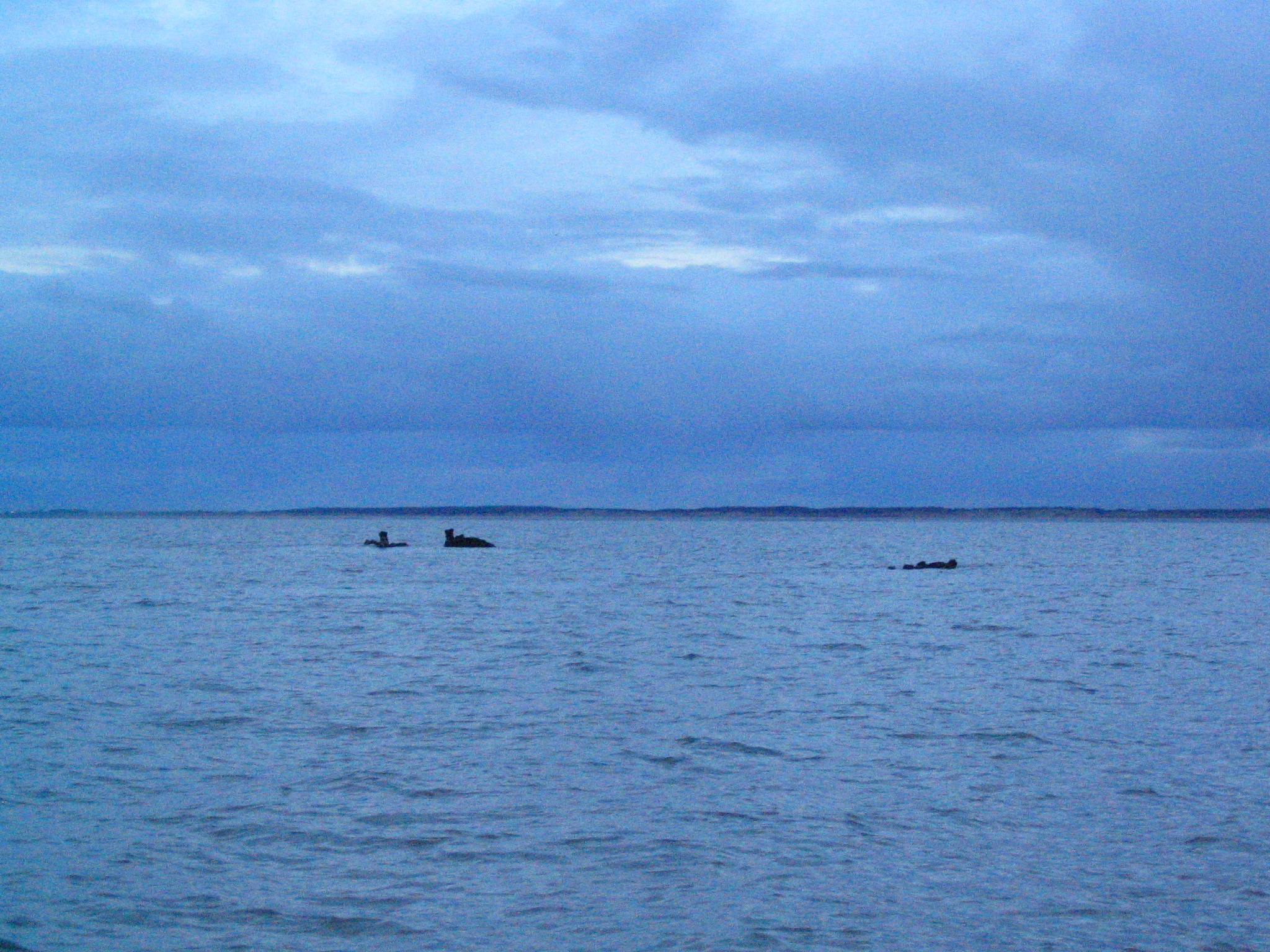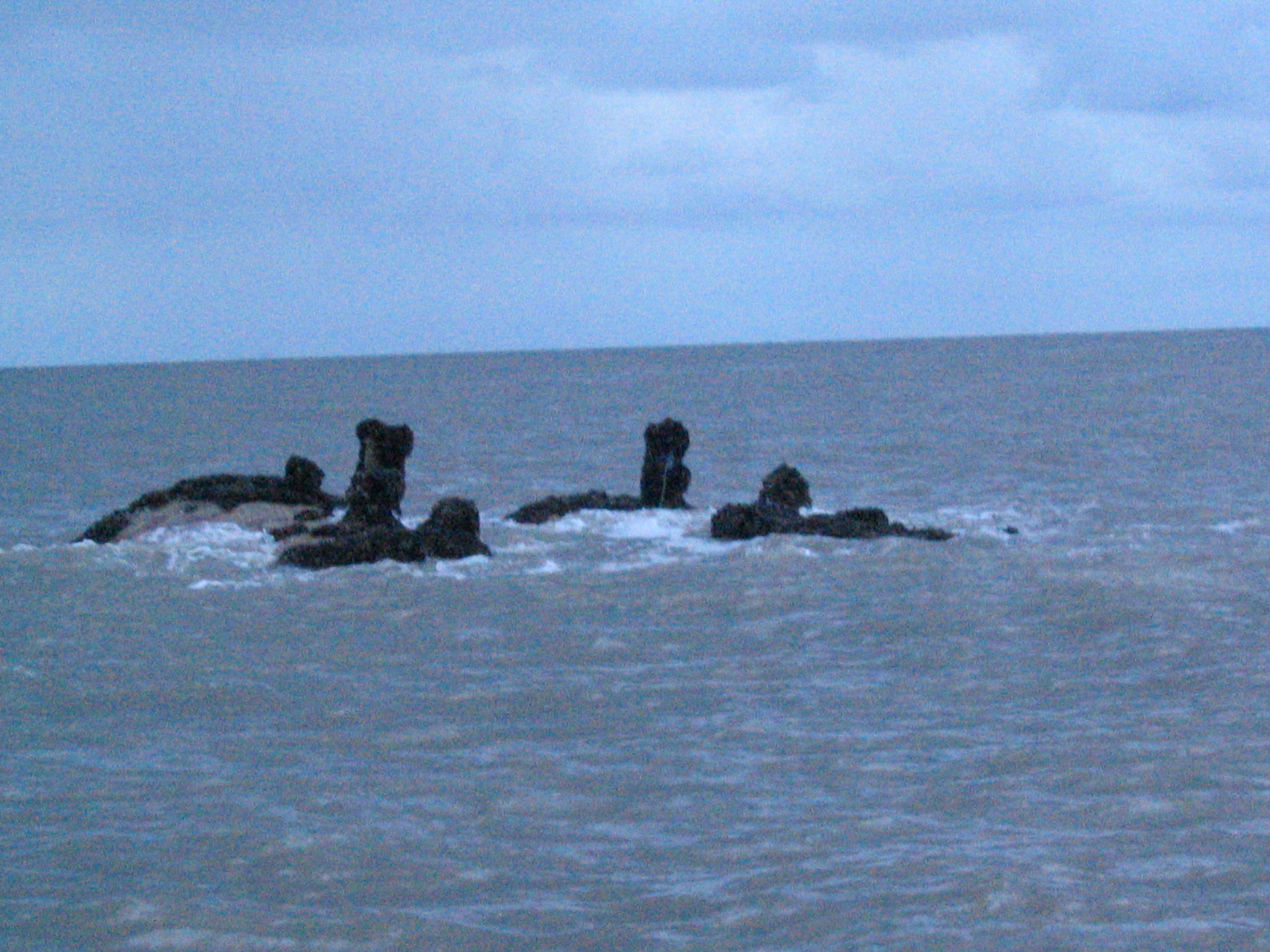

Two vessels which ended up in the same place - just north of the shipping channel into Liverpool: an area of wreckage visible at low water and charted as drying wreck (no height given) N of Taylors Bank at 53°32.14 N, 3°11.62 W.
From my observations, the wreckage dries about 6 ft at most - the photo shows it at a spring low tide about 1.2 metres above chart datum when it dried by 3ft.


SS Blair Nevis, built Ardrossan 1930, steel screw steamer,
4155 tons.
Voyage Mellili, Italy to Workington with iron ore (also reported as
bauxite).
On 13 February 1945, stormy weather, off North coast of Anglesey in
convoy
Was hit on port side by HMCS Orkney [River Class Frigate built
1943].
Damaged and taken to Taylor's Bank (north of Mersey shipping
channel) and run aground.
All crew saved - but vessel abandoned.
HMCS Orkney repaired at Dustaffnage and put back in service.
Court case found Orkney resposible for collision.
Blair Nevis had been involved in earlier war service -
transporting Polish troops from France in June 1940 [for which her
master, Captain Duncan MacCall, and Chief Steward were awarded the
Polish Cross of Valour]; attacked by a German e-boat off Great
Yarmouth on 24 November 1941 [she was towed by tugs to Yarmouth Roads,
with Great Yarmouth and Gorleston lifeboat in attendance].
LUBECA 499 ton German motor coaster built Wewelsfleth 1964
10-12-1977 sank in 45 minutes after collison with Q12 buoy (crew saved)
Wreckage removed in sections and placed in close proximity to wreck
of BLAIR NEVIS.
Liverpool Echo - Saturday 10 December 1977
SEVEN PLUCKED TO SAFETY IN THE MERSEY. By Alf Bennett. SEVEN MEN were
recovering to-day after being rescued from life rafts in the River
Mersey. They had abandoned ship after the 499-ton German coaster
Lubeca struck a buoy in the main Queens Channel and started taking
in water at a fast rate.
And 45 minutes later - at 1 a.m. today - the coaster,
outward bound in ballast from Eastham Lock to Rotterdam, sank. The
drama started shortly after midnight. Pilot Colin Newenhouse [C. A. Nieuwenhuijs], from
Wirral, was on board when the Lubeca struck the large Q12 buoy. A
single May-Day call was picked up by the tug Trafalgar and relayed to
Port Radar. And as a rescue operation swung into action, Mr.
Newenhouse and the six man crew - four Germans and two Turks - lowered
the liferafts. The Liverpool Pilot Boat. under the command of Captain
Ian Woods, went to their aid, and was given assistance by the dredger
W.D. Seven Winds. As the dredger beamed searchlights on the rafts
being tossed about by a Force Seven south-westerly gale, the Pilot
Boat launched a rescue craft which cast lines aboard. After a couple
of attempts, the lines were made fast, and the rescue boat towed the
two rafts back to the Pilot Boat. The 30-minute ordeal for the seven
men was over. They were taken to the city's Royal Southern Hospital
for a check-up, before being allowed to leave.
To-day, a warning was broadcast to shipping, and a buoy tender was
carrying out a precautionary check on the buoy - though it was still
giving off a signal. Dock officials are to investigate how to remove
the wreck. A Mersey Docks and Harbour Company spokesman said the
salvage vessel Salvor has been out to locate the wreck. and marked it
with a wreck-buoy. No interference is being caused to other river
traffic in the main channel. The Lubeca subsequently foundered in a
position just north of the entrance to the Channel.
[ie just north of Q2 buoy]
Liverpool Echo - Tuesday 20 December 1977
Salvage bid starts in Mersey. A massive salvage operation to lift the
German coaster Lubeca off the bed of the Mersey has begun. Divers from
a Southampton salvage company have already started surveying the ship,
which sank after colliding with a navigation buoy in the Queen's
Channel ten days ago, and hope to have her re-floated by Christmas. "Our
main problem at the moment is to pass the lifting cables under the
ships hull," said a spokesman.
Liverpool Echo - Wednesday 04 January 1978
BID TO LIFT SHIP ON AGAIN. Salvage work on the 499 ton German coaster which
sank in the Mersey before Christmas is expected to resume to-night
after a hold-up because of bad weather. The 2,837-ton floating salvage
crane Brunei heads out into the river tonight to continue preparing
for the massive lift operation on the Lubeca.
Lubeca foundered on December 10 after hitting a buoy in the main
Queen's Channel. The six crew and pilot were plucked from the sea to
safety by the Liverpool Pilot Boat.
Brunel,[R. B. Brunel, built HDW Kiel 1969, IMO 7603588, 2700
gt, ex-Magnus XI of Hamburg, later
Smit Cyclone] captained by Captain John Tasker, has been working in the
Mersey since before Christmas but bad weather has delayed the massive
lift operation. She has a 500-ton lift capacity - 1,000 tons with deck
tackle - and works in conjunction with the salvage ship Seaford. Brunel
worked all over Europe, but is particularly suitable for work on the
U.K. coast. She has worked in the Mersey before, moving dock gates, so
Mr. Roy Martin, general manager of Risdon Beazley Marine of
Southampton, the company which owns her, is aware of the problems.
"It's a difficult area to work in and a difficult time of year but we
shall accomplish our task."
Liverpool Echo - Thursday 05 January 1978
Floating crane all set for the big lift... The massive floating
crane, Brunel, may be out in the Mersey approaches several days before
attempting to lift the German coaster Lubeca, which sank in a gale on
December 10. The 3,000-ton Brunel sailed out of its station,
accompanied by the salvage tug Seaford. The crane will pass cables
beneath the coaster, which lies under water just north of the entrance to
the main Queen's Channel. The Lubeca will be lifted clear of the water
by the Brunel's 1,000-ton capacity crane and later beached at
Wallasey. An earlier attempt, before Christmas, to raise the coaster
was delayed by bad weather. Liverpool Port Radar, today reported winds
south to south west, Force Three, and Mr. Roy Martin, general manager
of Risdon Beazley Marine, which owns Brunel, is optimistic: "That's
what we are looking for. A couple of days of fairly calm weather."
Payment for the salvage, said Mr. Martin, is on the normal "no cure,
no pay." basis.
From Liverpool Nautical Research Society Bulletin:
On 12 January, again on a very stormy night, R.B. Brunel
lost both her anchors and was, for a time, without power. The tug
Seaford held her, hove to, in heavy seas, and the Hoylake lifeboat stood
by. Next day Liverpool tugs towed the crane into Liverpool for repairs.
Liverpool Echo - Monday 23 January 1978
Abandoned ship a hazard. Rough weather thwarts attempts to raise coaster. The
hazardous and expensive operation to raise a sunken German coaster has
been abandoned after successive storms broke up the ship.
But the 500 ton Lubeca, which foundered after striking a
navigation buoy in the mouth of the Mersey, still presents a serious
risk to shipping. For over a month, a 3,000-ton floating crane, two
large tugs and a team of six divers have battled against terrible
weather conditions to raise the ship and beach it. Eventually, the
salvage company, Risdon Beazley Marine, of Southampton, were forced to
abandon the operation without a penny in salvage money. The Lubeca,
which went down shortly after her seven crew were rescued, has now
fractured in at least two places and is drifting dangerously along the
sea bed into the Crosby Channel. The salvage company is not prepared
to reveal the amount of money they have lost on the operation,
although conservative estimates put this well into five figures.
During the last month they have hired the tug Trafalgar from the
Alexandra Towing Company and this, the smallest cost in the whole
operation, would have come at about £130 an hour. "No, we won't
get anything out of it now," said Roy Martin, general manager of the
salvage company. "The risks are something which few people
appreciate." If they had succeeded in bringing the Lubeca ashore they
would have made a considerable claim from the underwriters.
Several times the massive Brunel crane came
near to lifting the coaster out of the water after divers had looped
cables under her hull. "It slipped back two or three times," said Dave
Davies, one of the team of divers. "There was too much silt up in the
bows." In fact the crane did manage to wrench part of the wreck away
from the seabed and bring it back ashore. "It's not bits of the ship
you want." said Dave. Meanwhile the Mersey Docks and Harbour Company
is determined that the wreck of the Lubeca should be cleared by the
owners or the underwriters. "This wreck must be removed from the
waters of the port. The matter is still in the hands of the
underwriters, and it is they who will decide by what means this shall
be achieved," said a Dock Company spokesman.
Diver aboard crane-ship Brunel.

MDHB wreck report states that the Lubeca had been moved in sections by 20 June 1978 to a position [53°32'10"N, 3°11'32'W - OSGB36 datum] in close proximity to the wreck of the Blair Nevis. The original position of sinking had been swept clear to a depth of 7.3 metres (below LAT).